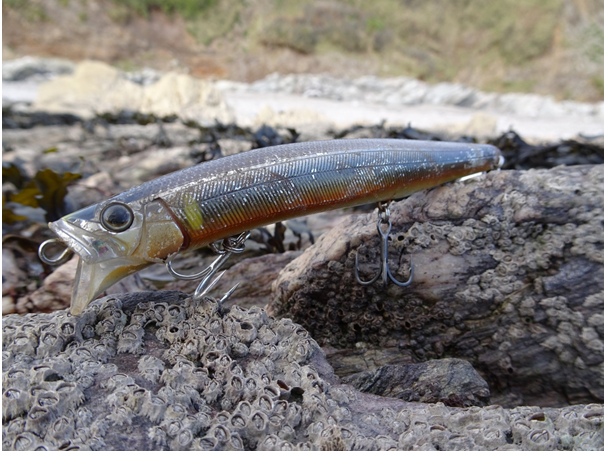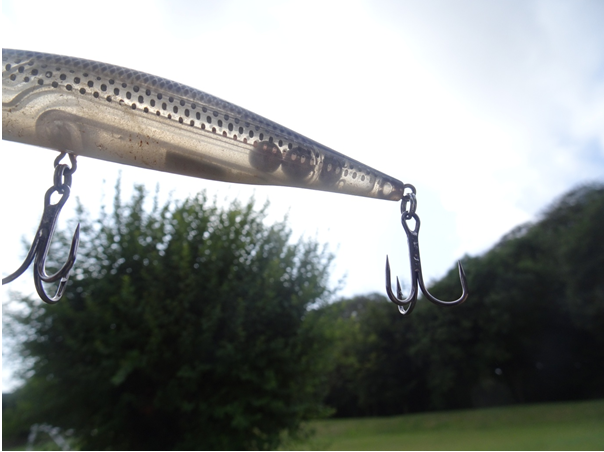Hard Diving Minnows – My Approach (Part 2 of 3)
Posted by Marc Cowling (South Devon Bass Guide) on 10th Aug 2019

In Part 2 of this series, I will continue to discuss the characteristics and attributes associated to the hard diving minnows that I use in the course of my personal and guided bass lure fishing sessions - namely:
- Swim depth
- Movement
- Size and Shape
- Casting capability
Swim Depth
The swimming or running depth of a hard diving minnow is determined by the size, shape or angle of the vane/lip or, if there is no vane/lip attached, then the angle of the slant on the lures snout. Lures with a small, yet vertically positioned dish-shaped lip (bottom in the photograph below) will, generally speaking, only dive to a maximum depth of around 30-40cm, whereas the lure at the top of the photograph has a larger, more pronounced lip/vane and will, therefore, dive and swim much deeper in the water column.

A deep diving (7-8ft), yet mediocre casting Rapala J13 (above)and a very shallow diving (1ft), yet long casting Megabass Kagelou 124F (below).
The good news is that if your intention is to utilise a deeper diving lure then you’re most probably fishing in relatively deep water. This means the bass are more likely to be very close to you and long casting isn’t necessarily required - just as well as most don’t cast all that well due to the increased wind resistance associated to the vane. A long casting shallow diver on the other hand, with its comparatively small vane or slanted face enables you to effectively search out vast areas of shallow snag-ridden territory.
Movement
When it comes to the movement of a hard diving minnow, unless you’ve previously witnessed the lure you intend to purchase ‘live’ or in action then it is very difficult (from looking at them on the web or in its packet in a Tackle Shop) how they will react when being retrieved. Furthermore, some lures will ‘swim’ more efficiently under either a quick, jerky or indeed, a slower retrieve style.

The ‘classic’ Tackle House Feed Shallow 128. I have owned this very lure for around 8 years now (hence the battered nature of its paintwork).
All will possess a wobble or a wriggle, but some lures will most definitely have a tighter action (the slimmer bodied lures generally) whereas the thicker-set lures such as the Tackle House Feed Shallow (the 105 and 128 in particular) have a very wide ‘snaking’ action under the water – both of which, on their day, could be more attractive to a bass.
Size and Shape
I’m a firm believer that by placing something in front of bass that looks (size, shape, movement and colour) as close to the real thing as possible, you are significantly increasing your chances of success. The sea around south Devon is, more often than not, clear to exceptionally clear, which when you add in the fact the most of my fishing/guiding takes place in water less than 8ft deep means that bass (as stated in Part 1 of this series) will very often get a very good ‘look’ at the lure.

Three of my best ‘sprat’ imitations (the Savage Gear Manic Prey, Ryobi Trapper Minnow and Tackle House Feed Shallow 105) alongside an obvious sandeel-shaped lure (a Savage Gear Jerk Minnow).
Even if the colour doesn’t make a difference (and I think it does) then the size and overall shape (or profile) of a lure most probably will. Again, it is details like this that could be the difference between a bass interrogating the lure and positively nailing it!
Casting Capability
I’ve already mentioned virtues such as a slanting-faced lure or a small vane being conducive to it having greater casting capabilities- but that isn’t all. The most competent lures in this arena are those that have the most efficient weight-transfer systems - ball-bearings that reliably and consistently preposition themselves from an internal furrow to the rear (or tail-end) of the lure under the momentum created when being cast.

Note the transferable bearings and the housing/furrow towards the centre of the lure (beneath the centrally positioned hook). As well as causing the lure to rattle, some lures have multiple moving bearings or maybe one large one (my preferred option that is customary in many IMA or Daiwa lures).
Something else to consider, is that there will always be an optimum weight-to-size ratio when it comes to a lure’s design. A great example is, once again, the Tackle House Feed Shallow range - as the 128 is what I would describe as a ‘fussy’ caster, whereas the 105 is a consistently great casting lure. Here, the 23mm less length and increased aerodynamic qualities are hugely significant when the lure’s deadly action/movement is retained.
Finally, in Part 3, I will concentrate on when I feel more confident in the bass catching capabilities of a hard diving lure, in conjunction with how I have utilised them more recently.
Marc Cowling (South Devon Bass Guide) is a fully insured, shore based bass fishing guide who specialises in catching this majestic sporting species on lures.
Read Part One.
